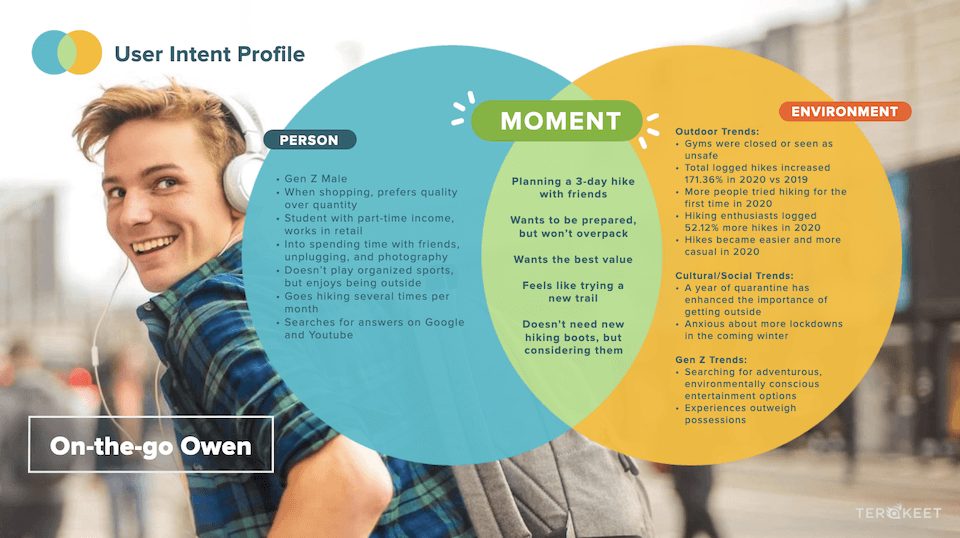
How to Create a Better Buyer Persona [Free Template]
Jan 7, 2022|Read time: 12 min.
Key Points
- A buyer persona is a semi-fictional representation of your ideal customer.
- Buyer personas allow you to understand the goals and struggles of your target customers.
- Buyer personas allow you to create effective marketing campaigns that resonate with your target audience.
If you manage marketing for an enterprise brand, you know how complex consumer shopping behavior is. The path to purchase is isn’t a straight line, and it often involves multiple digital and in-person experiences. To reach your customers, you need to know more than their name and address. You need to create an in-depth buyer persona built for digital consumers.
Whether you call it a user persona, an audience persona, or a customer persona, the definition is still the same.
What is a buyer persona?
Marketing term
Buyer Persona
A buyer persona is a semi-fictional representation of your ideal customer archetype. Personas include specific information like age, gender, occupation, location, pain points, goals, and desires.
We use buyer personas to better understand the customer experience from our audience’s perspective. Remember, each marketing persona represents a segment of real people.
When you understand the goals and struggles of a specific market segment, you can create highly relevant content that resonates more deeply with them. You’ll know what messaging is most effective and how to get your message in front of each persona. More importantly, you’ll find better ways to move them through your sales process.
0
%of high-performing organizations provide personas to internal sales teams
–ForresterIn fact, Forrester found that 48% of high-performing organizations provide personas to internal sales teams.
To serve your customers most effectively, you need to know everything about them. A buyer persona is a simple way to synthesize the most relevant information about a segment into a single profile. The more diverse your product range, the more buyer persona examples you’ll likely have.
If you’ve been using the same template for years, it’s time to rethink how you define your buyer personas.
The truth is, consumer behavior has rapidly changed in the last two years. So, the old method of creating buyer personas is obsolete. You need profiles that go beyond traditional demographics and explain behaviors, environments, and motivations.
In this complete guide, I’ll walk you through exactly how to define and create a better buyer persona. You can also download our free buyer persona template below to help you get started.
Buyer Persona Template
Build better buyer personas to meet your consumers’ needs.
Why buyer personas are important
User personas are critical decision-making tools for a brand because they identify actual customer segments within your target market. Customer personas help you optimize the buying journey, from in-store interactions to ecommerce purchases to post-sale customer support.
Marketing intelligence
A well-researched buyer persona gives you a deeper understanding of your ideal customers and prospects. As a result, it becomes easier to customize your positioning, content, messaging, products, and services to the specific pain points, desires, and goals of your customer base.
For example, if you sell cloud-based accounting software, your target customers might include both small and large businesses. Creating buyer personas for each segment of your audience helps you understand what matters most to them so you can adapt your marketing strategy for each one.
A small business may prioritize ease of use of the software, while an enterprise may be far more concerned with back-end technology integration, automation, and ongoing professional services.
Buyer personas enable you to identify the pain points and goals of each segment of your audience, and you can then adjust your copy, design, and product development accordingly.
This increases your conversion rates and boosts your customer lifetime value (CLV).
Without clearly defined buyer personas, there’s a good chance your marketing efforts will fall flat. Your messaging won’t resonate with your audience and you’ll struggle to attract new customers.
Make Connections that Matter
Uncover what your customers are looking for in real time and meet their needs with valuable content.
Business growth insights
Customer personas can also be a useful compass for business growth. They give you clarity regarding your ideal customer, what they want, and how best to appeal to them. You’ll have a more thorough understanding of the buyer journey and how to engage with prospects each step of the way. Moreover, if you are a B2B business, having buyer personas for key decision makers will help you engage with them more effectively.
You’ll also gain a better understanding of your competition and what you need to do to differentiate your business. You can structure your digital marketing campaigns in a way that positions you differently from your competition.
For example, if a competitor doesn’t have a strong content marketing or inbound marketing strategy, you can use that to your advantage.
Example of a buyer persona

Terakeet’s buyer persona includes customer search data which reveals how users think and ask questions. We call it a User Intent Profile.
This new, turbocharged version of the customer persona is fueled by data about your customers’ wants and needs, making it a key foundational element within your content strategy. If you know your audience’s questions, concerns, and motivations, then you can use that insight to guide keyword research and produce more relevant content.
How to create a buyer persona (step-by-step)
I’d like to point out that a buyer persona doesn’t need to be fancy to be effective. You can use a simple Google doc or a spreadsheet instead of a step-by-step tool like HubSpot. No matter how you build your persona, just make sure it’s actionable, focused, and distributed across your company.
Furthermore, if your prospective customers are in the B2B space, then you’ll need to build multiple detailed buyer personas. Although your ideal buyers might be the heads of online marketing, they will likely need approval from the CMO or even the business owner if pricing is beyond their normal budget.
Step 1. Research your audience
First, when building buyer personas you must thoroughly research all the different types of customers within your target audience. As a result, you’ll have a clear understanding of who they are, what they want, and why they want it.
The information you include in your customer personas will vary depending on your industry, audience, etc. Your personas might include things like:
- Age range
- Income / revenue
- Job title
- Priorities
- Goals
- Challenges
- Interests
- Industry
- Pain points
- Products desired
- Features desired
- Preferred social media platform
Your goal is to put yourself in the shoes of your customers and see things from their perspective. There are several ways you can research your audience.
Interview customers
The most effective way to understand your ideal customers is to talk to them directly. The voice of the customer is the strongest advantage you have to create buyer personas.
Ask them about their needs, desires, and goals. What do they want in a product or service, and what frustrates them most? Ask new customers how they found you, and ask loyal customers what has kept them around.
Here are some questions you can ask:
- How do customers find you?
- Why did they choose you over the competition?
- What do they like about your product or service?
- What would they change?
- Did they consider any other products or services?
- What was most important to them when making a purchasing decision?
Content Strategy Playbook
The Fortune 500 CMO’s guide to content strategy.
Talk to sales
Your sales team is on the front lines, so they regularly interact with prospects and existing customers. They can tell you what questions your potential customers frequently ask. They can also provide insight into what messaging resonates most with your audience, as well as the most pressing concerns prospects have.
Talk to customer service
Your customer service reps have a birds-eye view of what your customers struggle with the most. They hear feedback from existing customers first hand and they interact with potential customers as well. They can reveal common questions and friction points within the buying process.
Do market research
Market research reveals who your true competitors are and how you can differentiate your brand. Analyze your competitors’ marketing tactics as well as their products and services.
Effective ways to do market research include:
- Do keyword research to find your competitors most valuable search terms
- Analyze their website copy to learn their target audience
- Sign up to receive emails from the major players in your industry
- Follow their social media profiles
- Use an audience intelligence tool such as SparkToro to gain insights into their audience
- Attend industry events
Look at your own analytics
Tools like Google Analytics can tell you who is coming to your website, what content they’re consuming, and where they are in the buying process.
If you have a blog, you can see which posts are generating organic search traffic and whether visitors click other links after reading a post.
This data can give you a sense of what people are hoping to find on your website and if the pages they visit contain that information. It is also an excellent resource for customer journey mapping through your site.
Metrics like a high bounce rate and low time on page can be key indicators that the content on your site isn’t meeting the needs of visitors. Armed with this data, you can develop a more effective content strategy.
The Brand Intelligence Report
Exclusive AI insights, search trends, and brand strategies, delivered to your inbox.
Step 2. Organize and segment buyer persona data
The next step is to organize the data you’ve collected and segment it according to your own buyer persona. Consider organizing your data along the following lines.
Demographics
Demographic information includes things like age, income, education level, job title, etc. This data can help you understand your audience on a more general level. It can also inform specific marketing decisions.
For example, if a segment of your audience lives in New York City and another lives in Iowa, the language you use in your NYC messaging would be different than that used for your Iowa segment.
Pain points
While there may be overlap, each persona will have unique pain points. The pain points of a Fortune 500 Chief of Marketing will be different from that of a small business owner.
Understanding the unique pain points of each persona is essential for creating messaging that resonates.
Goals and objectives
The more you can demonstrate to a potential customer that you can help them achieve their goals and objectives, the more likely they are to become a paying customer. When you understand what motivates a particular segment of your audience, you can highlight these motivating factors in your marketing efforts.
Thoughts and feelings
Though a little more abstract, understanding how your customers think and feel about certain things is critical to understanding why they do what they do.
For example, there may be an audience segment that has tried a competitor’s product but abandoned it because it seemed too complex. They may have felt confused and frustrated and decided to look for a simpler solution that meets their needs.
You can differentiate yourself by offering that simpler solution and providing a much better onboarding experience.
Step 3. Research trends and market conditions
Shifting trends and market conditions can have a significant impact on how different types of people think, feel, and behave. Obviously, there will be new trends regarding what types of products are popular.
There will also be shifts in consumer preferences that must be taken into account.
For example, as cloud computing has grown increasingly robust over the past decade, more and more businesses want cloud-based, rather than on-site solutions.
But in order to truly understand your different personas, you also need to take into account broader changes that are taking place.
Which social factors influence your buyer persona?
Changes in social norms and attitudes can have a significant impact on how your audience thinks and what is important to them. For example, in recent years, there has been a marked change in what consumers want from brands. In addition to providing outstanding products, many consumers also prefer brands that are socially conscious and responsible.
Brands like TOMS shoes and Warby Parker took note of this shift and committed to giving their products to underprivileged people in other countries.
Your buyer personas should include any social trends that impact how potential clients and customers view your products and brands.
How does the political climate affect your customer persona?
Though we may wish otherwise, politics certainly impact the behavior of your buyer personas. There are times when, for whatever reason, products or services become linked to a political party or person. These stereotypes might not be true, but they influence people nonetheless.
For example, large, gas guzzling vehicles are often associated with people who hold conservative political views.
This perception influences who buys these types of vehicles. If your brand sells these types of vehicles, your marketing message to those without conservative political views may need to be very different.
What is your buyer persona’s physical environment?
Physical experiences also can have a significant impact on consumer behavior. This can include everything from minor inconveniences like seasonal allergies to recovering from major surgery. It can also include events, like having a child or being in an auto accident.
The more information you have regarding the physical experiences of different segments, the more you can understand what motivates them.
Step 4. Develop an empathy map
While a buyer persona profile can help you understand who your customers are, empathy maps can help you understand a customer’s unique perspective, needs, and wants.
Empathy maps are a visualization of your audience’s emotional state at key moments which informs the user experience design process (UX design). Stakeholders, product managers, marketing teams, sales teams, and creative teams work together to build an empathy map to help drive the user experience design process.
The four quadrants of an empathy map include:
- See – Who and what your customers see each day
- Hear – The messages, media, and people that influence your customers
- Think and feel – Thoughts, emotions, desires, aspirations, and fears that drive your customers
- Say and do – How your customers respond to various settings and situations
Empathy Map Template
Empathize with your audience at key moments to deliver greater value.
Step 5. Define key moments for your buyer persona
The data you collected provides insight into the “moments” that drive an audience member to seek products and solutions. These moments are crucial inflection points in the buyer’s journey because they combine emotions with needs. In other words, this is when someone is most likely to take action.
Step 6. Design your persona
The last step when creating buyer personas is to finalize the design. Although you may have dozens of pages of research, you should limit your final persona to one simple page. The more complex it is, the less likely people will use it.
You can design your own, or download our free persona template here. If you plan to make your own, here are a few design tips:
- Give your buyer persona a memorable name
- Use a large, high-quality headshot
- Group your insights into related sections
Operationalize your buyer personas
Finally, it’s critical to operationalize your customer personas. Distribute them across all customer-facing teams, including social media, content, customer service, UX, design, SEO, leadership, etc.
More importantly, don’t just email your personas to different departments. Keep them in a digital asset management folder so they are always up to date. If you make changes to your buyer personas, everyone will instantly have access to the most current information.





